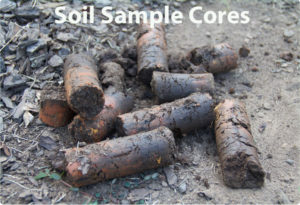Understanding Your Tele-Turf Soil Analysis
What Is The Soil Analysis?


During our onsite Tele-Turf visits, your specialist will use a tool known as a soil probe to take small plugs from the lawn. These plugs will be shipped to our soil laboratory for chemical and physical examination. This examination will tell us exactly what is going on at the molecular level within the confines of your lawn. It will give us the information we need to make adjustments to your program, or suggest other services that would best suit the desired results. Below, you will see a set of charts that are included in every soil analysis report. For the average homeowner, these are not easy to read. So we have put together this informative packet that explains each of the major components of the analysis and what it means to the lawns health.
Understanding Your Soil Analysis
Soil pH
Soil pH is a measurement that determines if the soil is acidic (pH values below 7.0) or basic (pH values above 7.0). Most soils have pH values in the range of 4.5 to 8.5, however, slightly acidic conditions usually are the most productive.
Acidic | Neutral | Basic | ||||
Strong | Moderate | Slight | Slight | Strong | Very Strong | |
pH 4 | pH 5 | pH 6 | pH 7 | pH 8 | pH 9 | pH 10 |
Organic Matter
Organic Matter (OM) refers to the stable by-products of decomposition that occur in the soil. The organic matter content, expressed as a percent, reflects the ability of the soil to supply nutrients, moisture and other physical benefits to growing plants. Productive soils can range from 0.5% up to 10% organic matter, depending on soil texture, local geographic and prevailing climatic conditions. Changes in organic matter content happen slowly but increases in OM are related to improvements in the health of the soil.
Calcium
Calcium (Ca) is an important constituent of plant cell walls, thereby giving overall strength to the plant. Calcium is also essential for good root development and may serve to neutralize some toxic compounds present in the plant. Calcium is abundant in mineral soils with pH above 6.0. Because calcium is the major component of limestone added to raise soil pH, it is adequately supplied to plants in the management of acidic soils as well. Calcium can be added to soil without raising the soil pH with applications of gypsum.
Soluble Salts or EC (Electrical Conductivity)
Soluble Salts or EC (Electrical Conductivity) is a measure of the salts in a soil that are soluble in water. It is determined by measuring the conductivity of a soil and water slurry in a 1:1 ratio. Soils have a wide range of salt levels, but generally, high salt levels are associated with soils where rainfall is limited and soils with poor drainage conditions. The salts accumulate at the soil surface rather than leaching throughout the profile. If irrigation water contains a medium or high amount of salt the accumulation process increases. High salinity, or salt content, can cause damage on salt sensitive crops.
Soil Texture | ||||
Degree of Salinity | Sand to Loamy Sand | Sandy Loam to Loam | Silty Loam to Clay Loam | Silty Clay Loam to Clay |
——mmhos/cm or dS/m—— | ||||
Non-saline | 0 – 1.1 | 0 – 1.2 | 0 – 1.3 | 0 – 1.4 |
Slightly Saline | 1.2 – 2.4 | 1.3 – 2.4 | 1.4 – 2.5 | 1.5 – 2.8 |
Moderately Saline | 2.5 – 4.4 | 2.5 – 4.7 | 2.6 – 5.0 | 2.9 – 5.7 |
Strongly Saline | 4.5 – 8.9 | 4.8 – 9.4 | 5.1 – 10.0 | 5.8 – 11.4 |
Very Strongly Saline | > 8.9 | > 9.4 | > 10.0 | > 11.4 |
Excess Carbonate
Excess Carbonate is the measure of the amount of free limestone in the soil. Knowing the relative carbonate content can be important in herbicide selection as well as selection of fertilizer application techniques. However, changing the amount of excess carbonate in the soil is difficult and economically impossible to do. The test measures the reactivity of the carbonate in the presence of acid.
When acids react with carbonates, such as calcium carbonate (found in chalk, limestone and marble), a salt, water and carbon dioxide are made.
Rating | Excess Carbonate |
Very Low | Not detected |
Low | Some detected |
Adequate | Moderately reactive |
High | Highly reactive |
Very High | Very highly reactive |
Phosphorus
Phosphorus (P) is an essential plant nutrient that is often low in soil and must be added as fertilizer. Phosphorus is a key nutrient for seedling growth because it contributes significantly to healthy seed formation and to initial root development after germination. Phosphorus is also directly related to energy transfers in cells that are vital to all growth processes.
The availability of phosphorus in soil is influenced by pH and mineralogy. Different analysis methods are used to give an index of availability in these various soil conditions. Bray is suited for neutral and low pH soil and Olsen is used on high pH (>7.2) samples. Mehlich 3 is used on most types of soil and across the pH range typically found in cultivated soils. Soil test ranges are similar for Bray and Mehlich 3 and lower for Olsen extractions.
Rating | Bray P, ppm | Mehlich 3 P, ppm | Olsen P, ppm |
Very Low | 0 – 8 | 0 – 8 | 0 – 5 |
Low | 9 – 15 | 9 – 15 | 6 – 9 |
Adequate | 16 – 20 | 16 – 20 | 10 – 13 |
High | 21 – 30 | 21 – 30 | 14 – 18 |
Very High | > 30 | > 30 | > 18 |
Potassium
Potassium (K) is another essential plant nutrient that is used in large amounts by plants and is typically added as fertilizer for maximized crop growth. Potassium is involved in controlling the flow of water through plants in transpiration and is also generally associated with winter hardiness and disease resistance. The soil test evaluates the readily available, or exchangeable, potassium content of a soil sample.
The common methods for extracting potassium for a soil test are ammonium acetate or Mehlich 3. These tests provide identical results. Other methods include extraction with Bray solution or a Mehlich3 extraction of a moist sample (not dried and ground as is typically done for soil testing methods). The following table provides the interpretations for these potassium extractions.
Rating | Ammonium Acetate and Mehlich 3, ppm | Bray K, ppm | Moist Soil K, ppm |
Very Low | 0 – 120 | 0 – 70 | 0 – 50 |
Low | 121 – 160 | 71 – 90 | 51 – 85 |
Adequate | 161 – 200 | 91 – 110 | 86 – 120 |
High | 201 – 240 | 111 – 150 | 121 – 155 |
Very High | >240 | >150 | >155
|

There is a simple equation for calculating the needs expressed in this portion of the analysis. By dividing by 43.56 (1 acre = 43,560 sqft) we can convert to 1000 sqft increments.
90/43.56=2.06 lbs per 1000 sqft. This number is easily achievable by normal fertilizer application.